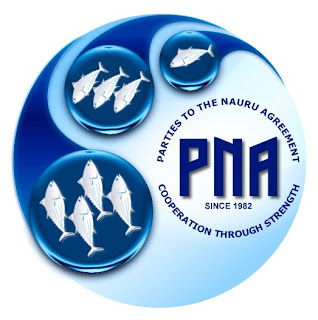Nauru is one of the countries party to the 1982 "Nauru Agreement Concerning Cooperation in the Management of Fisheries of Common Interest", along with the Federated States of Micronesia, Kiribati, Marshall Islands, Palau, Papua New Guinea, Solomon Islands, and Tuvalu.
The Nauru Agreement is very influential. Over the years, the Agreement has provided most of the impetus for improving the management of purse-seine tuna fisheries in the western tropical Pacific region, both at the policy level, and the detailed practical level through its various Implementing Arrangements.
The main point of the Nauru Agreement is that all eight Parties are applying the same management measures, and the same terms and conditions for access, to all tuna purse-seine vessels fishing in their waters. PNA (Parties to the Nauru Agreement) waters cover most of the best purse-seine fishing areas in the Western Pacific (a total of 15 million square kilometres), and thus through sub-regional cooperation, the PNA can essentially control the management of this fishery.
What is particularly significant is that the Western Pacific Tropical tuna fishery is in better shape than any other tuna fishery in the world. Although Pacific Island countries have concerns that Bigeye Tuna will become overfished if fishing effort is not reduced, overall these fisheries are not overfished - the skipjack stock in particular (the main tuna stock) is in good health - and actions are already being taken to reduce the impact on bigeye tuna to avoid it becoming overfished. The relative health of these Pacific fisheries is due in no small part to the strong control exerted by coastal States, particularly the Parties to the Nauru Agreement, whereas tuna fisheries management in other regions is dominated by industrial fishing interests.
The PNA countries jointly agreed on the
PNA third Implementing Arrangement at a PNA Ministers Meeting held in Palau in May 2008. Amongst other things, they agreed that any vessel found fishing for tuna in high seas areas enclosed by PNA exclusive economic zones would have its licences to fish in all PNA EEZs cancelled. There is also a ban on using drifting Fish Aggregation Devices for 3 months of the year and a requirement for purse-seiners to carry an observer aboard at all times. These measures will come into force on January 1st 2010.
There is a long lead-time between the signing of the agreement and its coming-into-force because it will take some time for regional and national observer programmes to gear up for 100% purse-seine coverage (currently it is around 20%) and to get the necessary regulations in place.
NFMRA is currently in the process of ensuring that Nauru can play its full part in this Agreement. A national observer programme is being started up, including the appointment of an Observer Programme Manager and obtaining accredited training for a cadre of Nauru observers, and also in developing regulations to put the 3rd Implementing Arrangement into practice.
These regulations have already been drafted with the assistance of Parliamentary Counsel and the Forum Fisheries Agency, and should be presented to Cabinet shortly. They will be posted on this website as soon as they are approved. However, the basic framework of the 3rd Implementing Arrangement is already agreed and it only remains to enact this under Nauru law.
Another shorter, temporary, set of regulations, to implement an additional measure agreed within the Western and Central Pacific Fisheries Commission - to prohibit purse-seiners fishing on drifting FADs and other floating objects during the months of August and September 2009 - will also be presented to Cabinet for approval.
These new conditions will subsequently be inserted in the conditions of all licences to fish in the Nauru EEZ by foreign fishing vessels.
It should be noted that Nauru small scale fishing boats and fishers are exempt from all of these rules, which are intended to tighten up controls on large-scale industrial fishing across the western pacific sub-region. And these measures will not limit the rights of PNA members, including Nauru, to increasingly participate in the industrial fishery in the PNA area.
 |
| FAD buoys aboard a purse-seiner |















